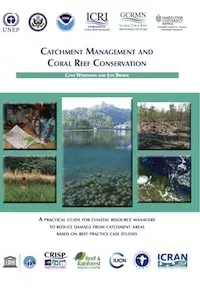A practical guide for coastal resource managers to reduce damage from catchment areas based on best practice case studies (Catchment Management and Coral Reef Conservation), by Clive Wilkinson and Jon Brodie was released at the International Marine Conservation Congress in Victoria BC Canada on 16 May.
The book aims to assist coastal resource managers deal with the problems arriving at the coast from rivers and streams. To date there has been no guide book for managers. The stimulus was that many coral reef managers reported on problems of sediment, nutrient, pesticide and litter pollution damaging their reefs and they did not know where to start.
 This 112 page book is an ideal training manual for catchment (watershed) management capacity building. It is based on 33 case studies of best practice catchment management from 70 authors and 22 countries from Brazil to Thailand. These case studies were used to develop 11 Major Recommendations in which there are 47 specific action suggestions. The case studies discuss how managers have tackled the major threats: sediments, nutrients, heavy metals, pesticides and litter; and also how to put climate change threats within this framework.
This 112 page book is an ideal training manual for catchment (watershed) management capacity building. It is based on 33 case studies of best practice catchment management from 70 authors and 22 countries from Brazil to Thailand. These case studies were used to develop 11 Major Recommendations in which there are 47 specific action suggestions. The case studies discuss how managers have tackled the major threats: sediments, nutrients, heavy metals, pesticides and litter; and also how to put climate change threats within this framework.
The suggestion for this book came from Dr. Veerle Vandeweerd who was the Director of the GPA office (Global Programme of Action for the Protection of the Marine Environment from Land-based Activities of UNEP (United Nations Environment Programme). Funding support came from ICRI members, especially from Department of State and National Atmospheric and Oceanographic Administration of the USA; UNEP; IUCN; ICRAN; IOC-UNESCO; and CRISP. Additional funding support came from James Cook University, Reef and Rainforest Research Centre (RRRC), Wildlife Conservation Society and the Townsville City Council.
This book is produced as a contribution to the International Coral Reef Initiative by the Global Coral Reef Monitoring Network and James Cook University Catchment to Reef Research Group, with the aim of conserving coral reefs for the future benefits of the world. Copies are free from the GCRMN or through some ICRI Partners around the world. The PDF version will be available shortly on the ICRI website.